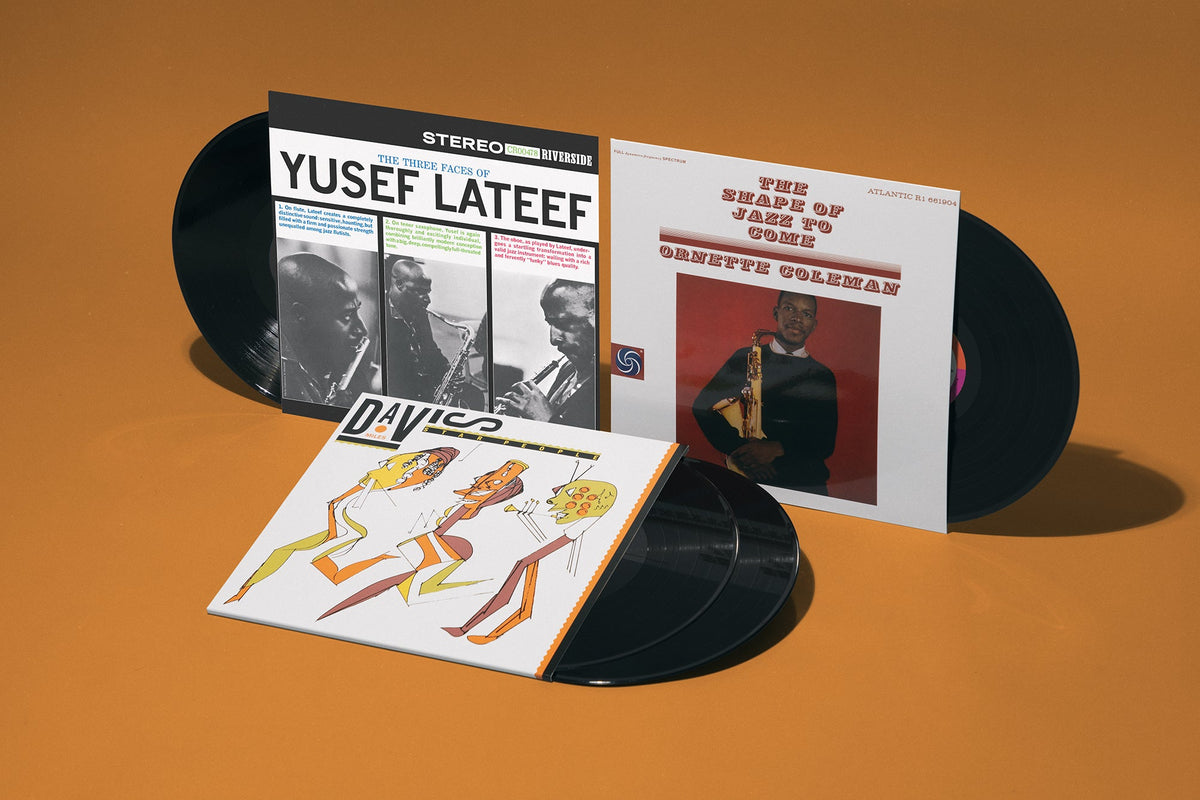Ornette Coleman’s Prescient ‘The Shape of Jazz to Come’
How his boldly titled magnum opus opened the door for the free jazz of the future
Ornette Coleman made his intentions clear right away: The alto saxophonist wasn’t looking to just get along in jazz, he wanted to overhaul the genre, moving it from straightforward chordal progressions to a strain with a less adhered-to structure. Even as his debut album, 1958’s Something Else!!!!, harbored the tenets of bebop, Coleman’s iconoclasm was evident. Through piercing horn blasts and peculiar rhythmic arrangements, thanks in part to an all-star team of players that included Don Cherry on cornet and Billy Higgins on drums, Something Else!!!! gave rise to a dissenting voice in jazz, one who would challenge what the music could — and would — entail.
That’s not to say the genre had become stale — quite the opposite. Eventual legends John Coltrane, Miles Davis and Thelonious Monk each added their own distinct flair to the music and culture; their respective albums from 1958 — Blue Train, Milestones and Misterioso — were cornerstone recordings that foreshadowed more ambitious fare. But where these artists exhibited a certain cool, Coleman brought a sullen intensity, the feeling of ominous storm clouds forming along the horizon. When paired with accelerated percussion, the sound could confuse and entice, and presented a strange juxtaposition of light and dark textures that conveyed various dispositions at once. Coleman split the difference between palatable musicians like Coltrane, Davis and Monk, and an enigmatic creator like Sun Ra, the pianist and organist whose progressive strain of jazz scored imagined space travel. Much like Sun Ra, Coleman set his sights on the future. He envisioned a broader landscape for Black music overall.
Born in Fort Worth, Texas, in 1930, Coleman grew up listening to the blues and taught himself how to play the sax on a horn his mother bought for him. For money, he played R&B tunes in local bars and worked in the service industry, and eventually joined the guitarist Pee Wee Crayton’s band. Because he loved bebop, Coleman initially had no qualms about playing this straight-ahead style of jazz. As the story goes, it was eventually the recorded work of legendary saxophonist Charlie “Bird” Parker who made him question the current state of jazz and push for something new. Parker would play complex versions of older standards, stretching his solos and making them tumultuous. Though the bones of the original songs were intact, through his own playing and that of his band, the composition almost became something new — like a remix, in a way. Coleman took this approach to heart, and soon applied this technique to his own music.
He moved to Los Angeles in 1953 to create a new type of jazz that eschewed tone and normal phrasing. There, he connected with Cherry, Higgins and bassist Charlie Haden, and formed the quartet that would reinvent jazz six years later. Long before the world dubbed it “free jazz,” Coleman called his music “harmolodics,” an unpredictable sound with restless tempos and chaotic fluctuations where harmony, melody and movement all share the same value. In his later years, he named it “sound grammar”; his 2006 album of the same name was nominated for a Best Jazz Instrumental Performance Grammy and won the Pulitzer Prize for Music a year later.
In 1959, Coleman released his boldly titled magnum opus, The Shape of Jazz to Come, on Atlantic Records. Prioritizing mood over traditional orchestration, it was the highest-profile free jazz album, released before the terms “free jazz” and “avant-garde jazz” even existed. Nowadays, through the labels International Anthem and Astral Spirits, and from acts like Irreversible Entanglements and Isaiah Collier & The Chosen Few, it’s common to hear free jazz that’s far beyond what Coleman assembled more than 60 years ago. Yet in those days, with the genre still buttoned-up and taking itself too seriously, his sound was radically different from what was accepted at the time. It elicited such a strong reaction from conventional jazz heads that some wanted to physically fight Coleman over what he was doing.
In November ’59, following the release of Shape, his band played a series of gigs at the famed Five Spot Café in Manhattan, where a who’s who of music royalty came to hear this buzzing new thing. Everyone from Davis, Coltrane and saxophonist Sonny Rollins, to the conductor Leonard Bernstein and the composer Gunther Schuller were there. After one gig, in particular, Bernstein jumped onto the stage and hugged everyone, exclaiming his love of the sound. Another night, a musician “kicked in the door … and tried to hit me,” Coleman told NPR. “He was very disturbed about calling me an avant-garde four letter word.” In a separate interview with The Wire, he said that some peers flat-out told him he couldn’t play the way he did. “I was being beaten up, my horn thrown away,” Coleman recalled. “I realized that whatever reasons the person had to make them treat me like that, it was what they had experienced … If they didn’t succeed, why should I succeed?” So went the cycle of his music in the late ’50s and early ’60s; listeners either loved it or hated it. Still, with The Shape of Jazz to Come, Coleman exhibited a bravery that hadn’t been displayed in the mainstream marketplace. It shook up a genre that became set in its ways and needed some new energy.
You can’t discuss this album without addressing the vaunted year of 1959, widely considered the best year in jazz history. Shape arrived three months after Davis’ landmark LP Kind of Blue, which brought a modal style to jazz and allowed its players to improvise within a fixed number of scales, and which remains the best-selling jazz album of all time. Coltrane, a lead player on Blue, recorded his breakthrough, Giant Steps, throughout the year and released it to widespread acclaim in February 1960. Elsewhere in 1959, the bassist Charles Mingus released the Afrocentric Mingus Ah Um, and the vocalist Abbey Lincoln returned with her fourth and most emotive release, Abbey Is Blue. The album Time Out, from The Dave Brubeck Quartet, was released to widespread acclaim and was the first LP to sell one million copies, and Art Blakey’s Moanin’ was heralded as a reset for the vaunted drummer and his Jazz Messengers.
But where others were already commercially viable and beloved by critics, Coleman was a newer entity with much to prove. He staked his claim on Shape’s opening song, “Lonely Woman,” a menacing cut with hypnotic bass droning and volatile squeals through a plastic sax that diverged from the drummer’s rapid swing. Coleman wrote the composition in part to cope with the loneliness he felt in New York City. “One night I was playing somewhere, and I saw a man arguing with a woman,” he once said. “She was so helpless about how the conversation was going … I just saw she was very sad. And my son and his mother had come to New York, and she had told me that ‘I can't raise Denardo out here, I’m going back to California.’ Then I made a connection between what this guy was doing and what I was involved with, so I sat down and wrote this song.” Though “Lonely Woman” is revolutionary in scope and sound (and is Coleman’s most popular track), the following tune, “Eventually,” is an equally blistering mix of bebop and swift horn blasts that impart urgency. What Coleman was nudging toward is open to interpretation, but the feeling of brisk motion was palpable.
Perhaps sensing the listener’s need for a break, the next song, “Peace,” is an aptly titled ballad with a walking bass line and faint drums mixed low to let Coleman and Cherry improvise without obstruction. Conversely, “Focus on Sanity” gives ample room to each musician, beginning atypically with a slow-grinding bass solo. The easiness is soon dashed; seconds later, the pace quickens for Coleman’s whinny shrieks and recedes for Higgins’ percussive outro. “Congeniality” pivots between bebop and bop, invigorating the album’s often-volatile aura with spirited brass solos that brighten the atmosphere.
Shape concludes with a rightful homage to “Bird” Parker, the guiding force who encouraged Coleman to push the boundaries of avant-garde jazz in the first place. Here, we get the bandleader’s two sides: the traditional Texas kid with an affinity for classic music, and the ambitious nonconformist hoping to turn jazz on its head. Launching with a bebop rhythm and short-bursting chords mimicking Parker, the track then moves to fully improvised solos with longer notes, closer to Coleman’s own aesthetic. As the song progresses, his sound grows shrill and extravagant without overtaking the melody. It doubles as a mission statement for this album and his art going forward, of his intent to honor the past while challenging listeners to imagine what the future could sound like.
On The Shape of Jazz to Come and other albums, Coleman used jazz as a springboard to greater exploration. By 1961’s Free Jazz, for instance, the bandleader broadened his music to include Freddie Hubbard on trumpet, Eric Dolphy on bass clarinet and Scott LaFaro on bass, which gave his work a more layered and disorderly sound. Coleman remained a polarizing figure: By the 1970s and ’80s, on releases like Skies of America and “The Sacred Mind of Johnny Dolphin,” he veered into classical terrain. In 1992, he crafted a bleak soundscape for the film version of writer William S. Burroughs’ Naked Lunch. These projects only heightened the intrigue surrounding Coleman. Even as a highly regarded genius, he was always searching for new ideas.
Yet a funny thing happened in the wake of Shape and Free Jazz: the tenor of the music started to change, even if Coleman didn’t receive full credit. By the mid-’60s, Coltrane constructed atop Coleman’s foundation with incessant saxophone wailing meant to summon higher powers. He, along with fellow saxophonists Albert Ayler and Pharoah Sanders, were at the forefront of a new wave of energy music — deemed spiritual jazz — though the roots were planted by Coleman on his third and most important album. Despite all the debate surrounding Shape, history has been kind to the LP, earning glowing retrospective reviews and catapulting the bandleader to iconic status. In 2012, it was added to the National Recording Registry and is widely considered one of the greatest albums of all time.
And if there’s lingering doubt about its importance, think how jazz might be without it. Coleman’s bravery opened the door for others to experiment with the genre in ways they wouldn’t have before. Without The Shape of Jazz to Come, who knows if Coltrane would have had the heart to try spiritual jazz, or if an up-and-coming pianist named Herbie Hancock would’ve been bold enough to blend funk into his atmospheric hybrid. Coleman was the first major artist to leap into unforeseen territory, and he did it at a time when the courage wasn’t always rewarded. It takes a special person to be the first to do something, and to endure ridicule and physical violence as a result is something else entirely. Despite the hardships, Coleman pressed on with his objective and did what the album declared he would. Jazz has never been the same, and we’re all better for it.
Marcus J. Moore is a New York-based music journalist who’s covered jazz, soul and hip-hop at The New York Times, The Washington Post, NPR, The Nation, Entertainment Weekly, Rolling Stone, Billboard, Pitchfork and elsewhere. From 2016 to 2018, he worked as a senior editor at Bandcamp Daily, where he gave an editorial voice to rising indie musicians. His first book, The Butterfly Effect: How Kendrick Lamar Ignited the Soul of Black America, was published via Atria Books (an imprint of Simon & Schuster) and detailed the Pulitzer Prize-winning rapper’s rise to superstardom.
Related Articles
Join the Club!
Join Now, Starting at $36Pages





